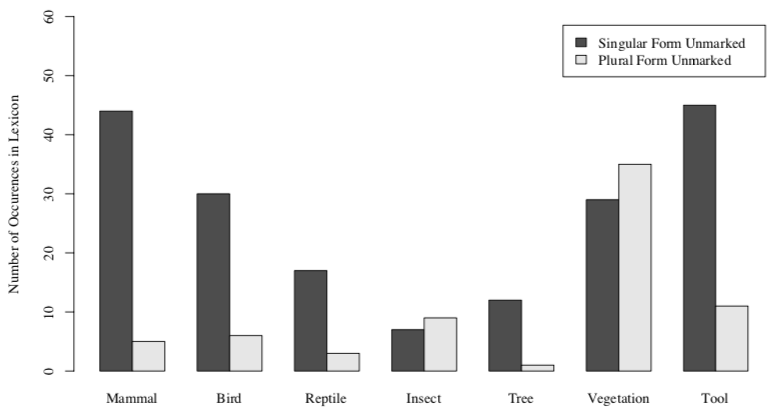Semantics and Pragmatics of Number
Summer 2019
1 Introduction to Nominal Number
Many natural languages mark nominal number in morphosyntactic ways.
1.1 Some facts about English
English typically distinguishes two nominal forms: unmarked (singular) and marked (plural).
| unmarked/singular | marked/plural |
| room | rooms |
| man | men |
| it | them |
The sheep drinks/drink from the stream. (Corbett 2000: p. 6)
- There is rope on the table. mass
- There is a rope on the table. count
Some nouns only have mass forms, e.g. blood, evidence, furniture.
Some nouns only have plural count forms (pluralia tantum), e.g. scissors, trousers, dregs.
1.2 Number morphology
Corbett (2000):§5.3 lists crosslinguistically common ways of marking number:
- Suffixation, e.g. English -s, Turkish -lar/-ler
- Apophony (word-internal sound change), e.g. man-men, goose-geese
Inflection, e.g. case inflection in Russian
стол
‘table’singular plural Nominative стол-_ стол-ы Accusative стол-_ стол-ы Geninitive стол-а стол-ов Dative стол-у стол-ам Instrumental стол-ом стол-ами Locative стол-е стол-ах Suppletion, e.g. человек-люди in Russian.
Reduplication, e.g. partial reduplication in Ilocano (Austronesian; Philippines) (Corbett 2000: p.149):
singular plural translation kaldíŋ kal-kaldíŋ ‘goat’ púsa pus-púsa ‘cat’ kláse klas-kláse ’class Sometimes you don’t see number morphology on the noun, but on the verb, as in Example 1.1.
1.3 More number categories
Some languages mark singuar-dual-plural, e.g. Slovenian, Sanskrit, Hawaiian. Some of these (e.g. Hawaian) only have dual forms for pronouns, others have dual forms for nouns (e.g. Slovenian, Upper Sorbian).
singular dual plural translation ja mój my 1st person pronoun ty wój vy 2nd person pronoun hród hrodaj hrody ‘palace, castle’ (Corbett 2000: p.20)Larike (Moluccan; Indonesia) marks singular-dual-trial-plural (Corbett 2000: §2.2.3).
Some languages mark paucal, e.g. Yimas (Lower Sepik; Papua New Guinea). Corbett (2000): p.23 says that a language that has paucal often marks dual as well.
There are languages that are said to mark quadral as well, but according to Corbett (2000): §2.2.5, the relevant data might be better analyzed as paucal.
Greater plural is used for an excessive/unusual amount, e.g. Niger-Kordofanian (Corbett 2000: p.31).
singular plural greater plural translation ngesa gese geseeli ‘field’ wuro gure gureeli ‘herd’ Food for thought: N after N in English seems to be geater plural (with obligatorily distributivity).
Greenberg (1963)’s Universal 34: No language has a trial number unless it has a dual. No language has a dual unless it has a plural.
Greenberg also says that no language has a plural unless it has a singular, but as Corbett (2000) :p.38 argies, there are languages with a plural and general number, not a singular, e.g. Japanese.
1.4 General number
Genereal number should be distinguished from singular.
In Japanese, Unmarked nouns are underspecified for number (similarly to ‘mass nouns’ in English).
niwa-ni kireina hana-ga saiteiru.
garden-LOC beautiful flower-NOM are.in.flower
‘There is a flower/are flowers in the garden’
There are ways to express mark plurality on nouns in Japanese.
- -tachi (Nakanishi and Tomioka 2004)
Example 1.4
sensei-tachi-ga hataraitieru.
teacher-PL-nom are.working
‘(The) teachers are working.’ - Reduplication (Sudo 2017)
Example 1.5
niwa-ni kireina hana-bana-ga saiteiru.
garden-LOC beautiful flower-flower-NOM are.in.flower
‘There are flowers in the garden.’
But there is no way to mark singularity on nouns in Japanese. You have to use a numeral (and a classifier).
Korean, Vietnamese, Mandarin Chinese are similar to Japanese in this respect.
But it’s not the case that a language with general number cannot have singular. E.g. Baiso (Cushitic; Ethiopia) has spearate forms for singular and general number (Corbett 2000: §2.1):
| general number | singular | paucal | plural |
| lúban | lubántiti | lubanjaa | lubanjool |
Note that the general number form is unmarked.
1.5 Singulative
Corbett (2000), p. 17 remarks that there is no language with two number cateogories such that the unmarked form is general number, and the marked form is singular.
There are languages where a small number of nouns show a pattern like this, e.g. Arbore (Cushitic; Ethiopia) (Corbett 2000: p. 17).
| singulative | general number | translation |
| tiis-in | tíise | ‘maize cob’ |
| lassa-n | lásse | ‘bread’ |
| nebel-in | nebel | ‘ostrich’ |
This type of singular marking should be distinguished from cases where the base form is plural, rather than general number, e.g. Welsh (Grimm 2012, 586).
| singulative | collective | translation |
| cacyn-en | cacwn | ‘hornet’ |
| picwn-en | picwn | ‘bee’ |
| chwann-en | chwain | ‘flea’ |
| dincod-yn | dincod | ‘seed’ |
| cneu-en | cnau | ‘nut’ |
Dagaar (Gur; Northern Ghana) exhibts a version of this called inverse number, where the same morpheme sometimes marks plural and sometimes singular, depending on the noun (data from Grimm, n.d.).
| singular | plural | translation |
| bíé | bíí-rí | child |
| nàŋá | nàn-ní | scorpion |
| bí-rì | bíè | seed |
| lúg-rì | lúgó | pillar |
